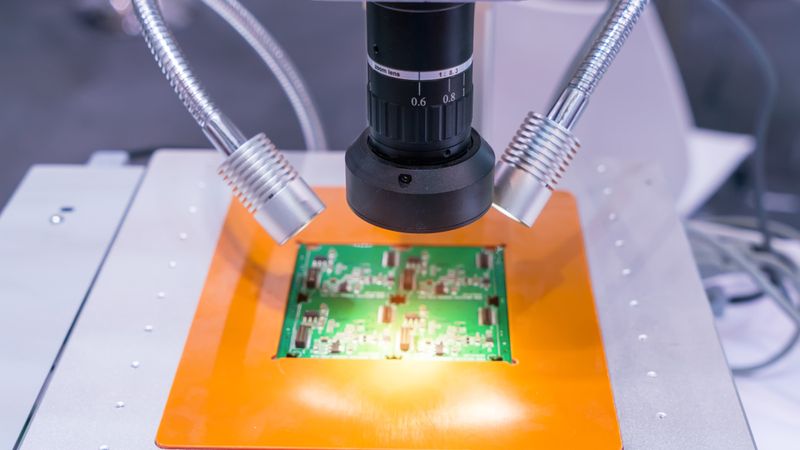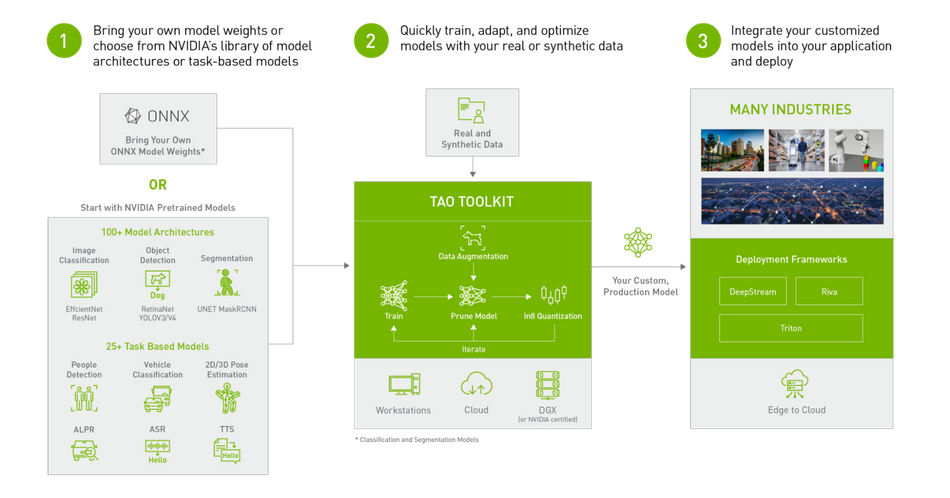Accelerating Edge AI Model Development Using Nvidia TAO and Edge Impulse
NVIDIA TAO and Edge Impulse integrate to streamline the development and deployment of edge AI models, empowering developers to quickly build and optimize AI applications for diverse hardware environments.
Introduction
In an era where rapid technological advancements continuously reshape how industries operate, edge artificial intelligence (AI) has emerged as a critical driver of innovation and efficiency. Edge AI brings computation and data storage closer to the locations where it's needed, accelerating response times while reducing bandwidth use. This technology is particularly transformative in industrial and commercial applications, where real-time data processing can significantly enhance operational efficiency and decision-making.
Enter NVIDIA Train Adapt Optimize (TAO) toolkit—an open-source suite designed to simplify and accelerate the creation of high-quality, customized, and enterprise-ready AI models. This toolkit democratizes access to state-of-the-art AI capabilities and streamlines the development process, enabling rapid deployment across a range of devices from cloud infrastructures to edge units.
When integrated with Edge Impulse, a leading development platform for edge AI, NVIDIA TAO becomes part of a powerful ecosystem that enhances the capabilities of developers and engineers to bring AI models to production faster. NVIDIA TAO and Edge Impulse represent a formidable combination, poised to accelerate the adoption of edge AI technologies across various sectors by offering tools that reduce complexity and enhance productivity.
This article explores how the NVIDIA TAO toolkit, along with Edge Impulse, facilitates the development and deployment of AI models on edge devices, illustrating the tangible benefits and real-world applications of this integration. By harnessing these advanced tools, developers can speed up the AI development lifecycle and achieve greater scalability in their AI projects.
The NVIDIA TAO Toolkit
NVIDIA TAO Toolkit is a great tool for developers aiming to harness the power of AI without the complexity typically associated with such endeavors. As an open-source solution, it democratizes advanced technology, allowing a broad range of developers—from startups to large enterprises—to create customized, high-performance AI models that are both scalable and adaptable.
Overview of NVIDIA TAO
At its core, the NVIDIA TAO Toolkit facilitates AI model development by leveraging NVIDIA's extensive expertise in AI and deep learning. Designed to streamline the process of model training and optimization, NVIDIA TAO empowers developers to build sophisticated AI models without deep specialization in AI technologies. Its open-source nature ensures that it is continually refined by contributions from the global development community, enhancing its capabilities and accessibility.
The Power of Transfer Learning
One of the most significant features of the NVIDIA TAO Toolkit is its utilization of transfer learning. This technique revolutionizes how models are built by allowing developers to start with an existing model—pre-trained by NVIDIA or third-party sources on vast and diverse data sets—and customize it to their specific needs with relatively little data. This method drastically reduces the time and resources required for model training and enhances the model’s accuracy and performance from the outset.
Transfer learning mimics human learning dynamics, where knowledge gained in one context is repurposed for another. For AI development, this means a developer can take a model that recognizes general objects and retrain it to recognize specialized equipment or scenarios specific to their industry. This flexibility opens up a plethora of applications, from enhancing manufacturing processes with visual inspection tools to improving safety protocols through real-time anomaly detection.
Key Features and Benefits of NVIDIA TAO
The NVIDIA TAO Toolkit offers a suite of capabilities that streamline the development process for AI models. Here, we explore how its features cater to efficiency, accuracy, customization, and deployment flexibility.
Efficient Model Training
The NVIDIA TAO Toolkit simplifies the model training process significantly. Developers can leverage TAO’s AutoML capability, which automates much of the model tuning. This not only speeds up the model development cycle but also makes it more accessible to non-specialists. The AutoML feature efficiently navigates through the complexities of model tuning, allowing developers to focus more on application development rather than the nuances of model configuration.
High Accuracy and Customization
NVIDIA is renowned for its high-performance computing and deep learning technologies, and TAO is no exception. It enables the creation of highly accurate AI models tailored to specific needs using state-of-the-art vision transformers and NVIDIA's pre-trained models. These capabilities allow for the development of bespoke AI solutions that are finely tuned to the unique requirements of different use cases, from healthcare diagnostics to automated surveillance systems.
Optimization for Inference and Deployment Flexibility
Once a model is trained, ensuring it performs efficiently on the intended hardware is crucial. NVIDIA TAO facilitates this by enabling significant optimizations for inference, enhancing model accuracy and performance across GPUs, CPUs, and cloud servers. Additionally, Edge Impulse extends this adaptability to various deployment platforms, including microcontrollers and various other edge devices, ensuring that models integrate smoothly with existing infrastructures.
AI-Assisted Data Annotations
Preparing data for training AI models is often labor-intensive. NVIDIA TAO eases this burden with AI-assisted data annotation capabilities. This feature accelerates the preparation of training data, making it faster and less costly.
Integrating NVIDIA TAO with Edge Impulse
The collaboration between NVIDIA TAO and Edge Impulse presents a synergistic approach to edge AI development, significantly reducing time-to-market while increasing the scalability and efficiency of AI solutions. This integration facilitates a streamlined workflow from model creation to deployment, addressing key challenges in edge AI development.
Enhancing Edge AI Development
By incorporating NVIDIA TAO into the Edge Impulse development platform, developers gain access to a robust set of tools designed to expedite the creation of efficient models. This integration leverages the strengths of both platforms—TAO’s powerful model training and Edge Impulse’s sophisticated deployment capabilities. Together, they simplify the development cycle, enabling developers to rapidly prototype, iterate, and deploy AI models that are both robust and scalable.
Comprehensive Edge AI Solution
The combined power of NVIDIA TAO and Edge Impulse provides a comprehensive solution for edge AI. From collecting data on edge devices to training and validating models and finally optimizing libraries to run efficiently on target hardware, this integration covers all bases. It supports a wide range of devices, from low-power microcontrollers to more capable GPUs, ensuring that developers can deploy their AI solutions across diverse modern IoT and edge computing environments.
Developers can tailor their solutions to specific hardware and performance needs, optimizing resource usage and operational efficiency. Additionally, the combined ecosystem supports a variety of silicon and sensors, making it an all-in-one solution for edge AI applications.
Practical Applications and Success Stories
The integration of NVIDIA TAO with Edge Impulse offers a powerful platform for practical applications in various sectors. Here, we explore some specific use cases that demonstrate the effectiveness of this technology.
PCB Classification: In electronics manufacturing, ensuring that all components are correctly placed and functional on a PCB is crucial. A minor error can lead to a malfunctioning device, leading to increased costs and reduced consumer trust. The PCBClassification model, developed using NVIDIA TAO, addresses this challenge effectively.[1]
This model utilizes an advanced AI architecture known as global context vision transformer (GCViT), initially trained on a comprehensive image dataset (NVImageNet). The model's training involves transfer learning, where a model developed for one task is partially retrained to perform another. In this case, the base model, proficient in general image recognition, is fine-tuned to specifically identify missing or defective components in PCB images.
The process is straightforward yet powerful: images of PCBs are fed into the model, which has been trained to recognize various components like resistors, capacitors, and inductors. The model assesses each component's presence or absence and checks for defects. This automated inspection helps quickly spot errors during the manufacturing process, reducing the likelihood of defective products reaching the market.
The accuracy of this model is notable, achieving near-perfect precision in tests. This high level of performance is crucial for industries where the cost of errors can be exceptionally high, both financially and in terms of brand reputation.
Reducing Baggage Delays at Airports: The case of Trifork using NVIDIA TAO for baggage tracking at airports highlights the transformative potential of these technologies in enhancing operational efficiency.[2] By deploying vision AI solutions, Trifork has been able to track millions of pieces of luggage, significantly reducing baggage delays and lost baggage incidents. This application not only improves the passenger experience but also optimizes the workflow and resource allocation at airports.
Industrial Defect Detection: Another compelling application is in the field of industrial defect detection.[3] Using NVIDIA TAO, developers have created models that can identify defects in various industrial products with high precision. This application is particularly beneficial for quality control in manufacturing, where detecting and addressing defects early in the production process can lead to substantial cost savings and maintain high-quality standards.
Retail Recognition: In the retail sector, the application of NVIDIA TAO for retail recognition tasks illustrates how edge AI can transform inventory management. The models could help with identifying a vast array of retail Stock Keeping Units (SKUs), facilitating better stock management, customer service, and logistical efficiency. By automating the recognition process, retailers can ensure more accurate inventory tracking and faster response times, leading to enhanced operational efficiency and customer satisfaction.
These practical applications and success stories demonstrate the broad utility and effectiveness of NVIDIA TAO when integrated with tools like Edge Impulse. The technology not only drives innovation and efficiency in existing processes but also opens up new possibilities for smart manufacturing, retail management, and beyond.
Further reading: A Practical Guide to Understanding Sensor Fusion with Edge Impulse: Building a Smart Running Jacket
Getting Started and Resources
To begin utilizing NVIDIA TAO and Edge Impulse to develop and deploy AI models on edge devices, it's essential to engage with a variety of resources and steps designed to streamline this process.
Firstly, a thorough exploration of the available documentation is crucial. Both Edge Impulse and NVIDIA provide comprehensive guides and tutorials on their respective websites. These documents are invaluable for understanding how to effectively integrate NVIDIA TAO models into Edge Impulse projects.
Additionally, Edge Impulse and Nvidia provide YouTube videos that detail the application and integration of NVIDIA TAO. These resources complement the written documentation and provide a medium through which users can understand how to work with these technologies.
Support doesn’t end with documentation and tutorials. NVIDIA and Edge Impulse have active forums like - Edge Impulse Forums and NVIDIA Developer Forums, where users can engage with a community of like-minded individuals. These forums are a great place to seek advice, ask questions, and share experiences related to edge AI development.
By leveraging these resources, developers can effectively navigate the initial learning curve and start applying NVIDIA TAO and Edge Impulse to real-world projects, gradually building up to more complex applications as familiarity with the tools increases.
Further reading: Building High-Performance Edge AI Solutions with Nvidia Jetson and Edge Impulse
Conclusion
The integration of NVIDIA TAO and Edge Impulse brings in a new era of edge AI development, offering developers powerful tools to enhance the efficiency and effectiveness of their AI models. This combination brings together NVIDIA's advanced AI modeling capabilities with Edge Impulse's robust customization and deployment framework, enabling rapid development, optimization, and deployment of AI applications across a variety of platforms and devices.
For developers and companies venturing into edge AI, the synergy between NVIDIA TAO and Edge Impulse provides a competitive edge. By simplifying complex processes and reducing the time-to-market, this integration democratizes advanced AI technologies and empowers a broader range of users to innovate and solve real-world problems.
References
[1] PCBClassification Model Card, Nvidia, 17 Oct 2023, [Online], Available from: https://catalog.ngc.nvidia.com/orgs/nvidia/teams/tao/models/pcb_classification
[2] Trifork - Reducing baggage delay at airports with vision AI, Nvidia, [Online], Available from: https://resources.nvidia.com/en-us-metropolis-software-success-stories/trifork
[3] Nirmal Kumar Juluru, Zaid Pervaiz Bhat and Samuel Ochoa, ‘Transforming Industrial Defect Detection with NVIDIA TAO and Vision AI Models’, Nvidia, [Online], Available from: https://developer.nvidia.com/blog/transforming-industrial-defect-detection-with-nvidia-tao-and-vision-ai-models/


